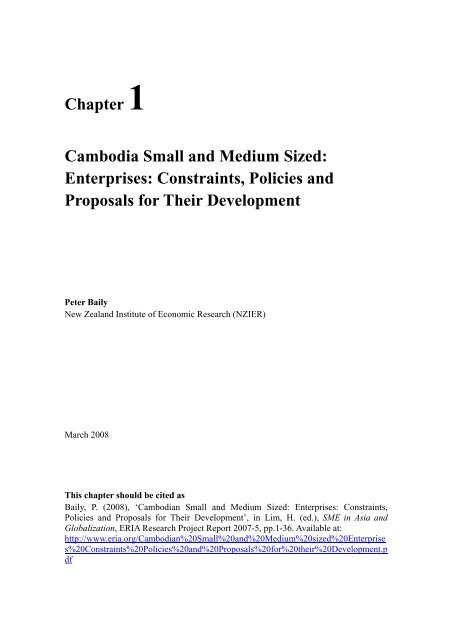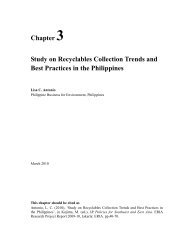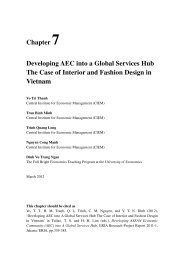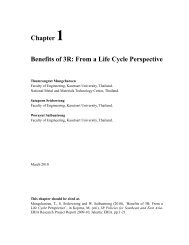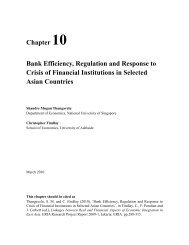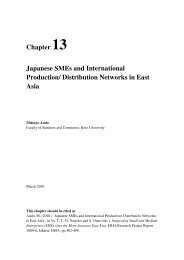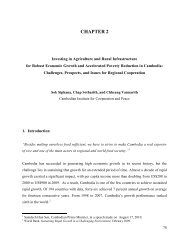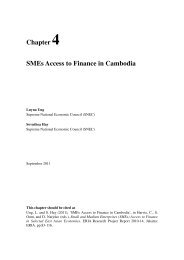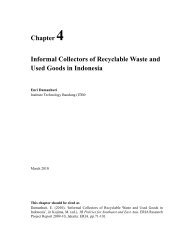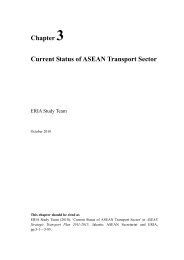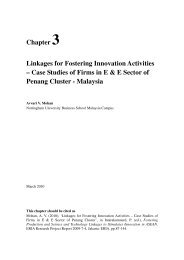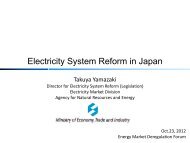Chapter 1 CAMBODIAN SMALL AND MEDIUM SIZED ... - ERIA
Chapter 1 CAMBODIAN SMALL AND MEDIUM SIZED ... - ERIA
Chapter 1 CAMBODIAN SMALL AND MEDIUM SIZED ... - ERIA
- No tags were found...
Create successful ePaper yourself
Turn your PDF publications into a flip-book with our unique Google optimized e-Paper software.
<strong>Chapter</strong> 1Cambodia Small and Medium Sized:Enterprises: Constraints, Policies andProposals for Their DevelopmentPeter BailyNew Zealand Institute of Economic Research (NZIER)March 2008This chapter should be cited asBaily, P. (2008), ‘Cambodian Small and Medium Sized: Enterprises: Constraints,Policies and Proposals for Their Development’, in Lim, H. (ed.), SME in Asia andGlobalization, <strong>ERIA</strong> Research Project Report 2007-5, pp.1-36. Available at:http://www.eria.org/Cambodian%20Small%20and%20Medium%20sized%20Enterprises%20Constraints%20Policies%20and%20Proposals%20for%20their%20Development.pdf
2.2 GrowthThe subsequent growth of Cambodian SMEs has been remarkable considering the levelof devastation of infrastructure and institutions during the country’s recent civil war,and the banning of commerce from 1975 to 1979 under the Khmer Rouge (KR). By theearly 1980s agro-industry food processing activities, predominantly rice milling, hadstarted taking place under the cooperative sector. By the mid 1980s a host of smallprivate enterprises providing basic manufactured goods, such as fish sauce, hademerged to meet growing domestic demand. 7 Nationalised SMEs were sold or leased tothe private sector from late 1989, and in 1991 the government introduced a full-scaleprivatisation programme. Macro-economic stability had been largely achieved by thelate 1990s and basic infrastructure and institutions had been rebuilt providing theplatform for growth of SMEs. 8The number of Cambodian manufacturing SMEs has increased steadily since thelate 1980s. A National Institute of Statistics (NIS) survey of industrial firms shows thatTable 1: Registered SMEs by industryEnterprise type 1998 1999 2000 2001 2002 2003 2004 2005Food, beverage andtobacco18,590 19,147 20,152 21,871 21,568 20,869 22,712 23,343Textile wearing apparelleather310 396 366 2382 1,417 1,406 1,672 1,662Wood productsincluding furniture895 814 869 141 13 13 16 -Paper products printingpublishing26 23 24 23 15 21 25 31Chemicals petroleumcoal plastics55 67 297 277 275 96 120 153Non-metallic mineralproducts811 777 666 721 757 681 680 718Fabricated metalproducts1,375 1,647 1,824 1,454 1,899 1,850 2,239 2,222Other manufacturing 2,035 1,356 1,208 1,286 976 1,049 667 618Total 24,097 24,227 25,406 28,155 26,920 25,985 28,131 28,747Notes: SMEs in this data set are defined as employing up to 50 people. There are very fewenterprises that employ between 50 and 100 people in Cambodia, so not including this groupstill provides a reasonable estimation of enterprises with fewer than 100 employees.Source: Cambodian Ministry of Industry Mines and Energy, Cambodian National Institute ofStatistics Yearbook 20063
Table 2: SME definitionEmployee number Assets excluding land US$Micro Less than 11 50,000Small 11 – 50 50,000 – 250,000Medium 51 – 100 250,000 – 500,000Large Over 100 Over 500,000Source: Royal Government of Cambodia Sub-committee on Small and MediumEnterprises SME Secretariat Small and Medium Enterprise DevelopmentFramework 2005For the purpose of this report, unless otherwise stated, the classification SMErefers to any enterprise with up to 100 employees.2.5 SMEs todayToday the vast majority of Cambodian manufacturing SMEs are small family runbusinesses, involved in basic processing of primary produce for the domestic market.There are very few who export directly or by supplying larger domestically basedexporting firms. Few have formal contracts or more than basic interactions with othercompanies. A lot of commerce is based around personal relationships.According to MIME data, in 2005 over 80 percent of Cambodian industrialSMEs were involved in food, beverage and tobacco industries, (see Figure1). NISsurvey data from 2000 show similar findings, with close to 80 percent of manufacturingSMEs from a sample of nearly 8,000 businesses involved in food, beverages andtobacco. Furniture manufacturers made up a further seven percent of the sample. Smallscale textile and garment, machinery and non-metallic mineral producers made up thebulk of the remaining 13 percent. There is also a small number of Cambodian SMEsinvolved in traditional handicrafts and chemicals. 16The high concentration of manufacturing in the early industries (food,beverages, tobacco: textiles and clothing) is unusual. By comparison in low incomecountries it is common for early industries to produce about half of manufacturing value6
While it is not unusual for a country with a small population to have so manysmall SMEs, this may indicate barriers to enterprise development. Traditionally, in awell functioning economy micro-enterprises develop into small enterprises, some ofwhich develop into medium sized and large enterprises. Few Cambodian companieshave developed in this fashion.On the other hand, there is evidence that much of the growth in SME numbers,discussed above is due to increases in numbers of small as opposed to micro enterprises.Data from the Ministry of Planning (MoP) shows that the number of firms employingbetween 10 and 49 workers as a percentage of all firms, increased from 39 to 79 percentbetween 1993 and 2001. During the same period the number of firms employing fewerthan 10 workers (micro enterprises) decreased as a percentage of all firms from 60 to 20percent. 20 The SME survey associated with this report supports these findings,providing evidence of a number of firms developing from micro to small to mediumsized enterprises.2.6 SME performanceWithin the manufacturing sector NIS data shows per worker output is almost alwayshigher for small firms than it is for large firms. 21 In the manufacture of food andbeverages gross output per worker is over twice as high for small as it is for largeenterprises (see Figure 2).However, Cambodian SMEs have low total factor and labour productivityrelative to neighbouring countries. By both measures, productivity of Cambodian firmslags behind enterprises in almost all other Asian nations. A 2004 World Bank (WB)study shows Cambodian firms to have total factor productivity 18 percentage pointsbelow those of India and 24 percentage points below those of China. Labourproductivity is 65 percentage points below that of India, and almost two thirds belowthat of China. 228
Figure 2: Gross value added per worker in 2000Notes: Small firms are defined here as having fewer than 10 employeesSource: Cambodian National Institute of Statistics Yearbook 20062.6.1 Physical capitalThe productive capital used by Cambodian SMEs is often old and inefficient relative tothat used in neighbouring countries. Companies are hampered in their abilities toupgrade due to an under-developed financial market. Many lenders simply increase thecost of credit to compensate for perceived risks. Investment is further hindered by aweak rule of law and weak institutions. It can cost considerably more than a loans valuefor a lender to seek legal recourse following a default.To some extent the use of old and basic machinery also reflects a lack ofhuman capital. Older machines are easier to repair with basic knowledge when theybreak-down.2.6.2 Human capitalCambodians generally have limited formal educated and training and have fewopportunities to enhance their human capital. The World Bank reports that in 20039
nearly 97 percent of the country’s manufacturing workers were unskilled and less than aquarter of Cambodian firms provided formal training to workers. 23Even a basic education is unavailable to many Khmers. There is a majorshortage of qualified teachers and less than three percent of the country’s GDP is spenton public education. 24 Although primary and junior high school education is officiallyfree and compulsory, low official wages lead to teachers demanding fees from students,and families often remove children from school to help harvest and prepare family plotsof land.For students there is little motivation to study, as well-paying jobs are usuallygiven based on family contacts, not ability.3. THEORIES OF DEVELOPMENTVery generally theories of Asian development can be classified into two groups. On onehand are accumulation theories, where the accumulation of physical capital andupgrading technology is vital for economic development. On the other hand areassimilation theories, where factors such as entrepreneurship, innovation and the abilityto learn and adopt technology are of crucial importance for enterprise and economicdevelopment. The relevant importance of accumulation verses assimilation is debated,but it is obvious that some mix of both is required for nations and enterprises to develop.Empirically the high rates of growth in Asian economies has been characterised by highrates of growth in both physical and human capital.Many of the following barriers and recommendations reflect the importance ofphysical and human capital. Providing a level playing field where Cambodian SMEscan access and upgrade capital would go a long way towards enabling these enterprisesto develop.The Small and Medium Industry Development Corporation of Malaysia(SMIDEC) have identified four stages of enterprise development. During the initialstage factors such as access to an adequate workforce and raw materials, and10
satisfactory infrastructure are crucial for development. As the enterprise enters thesecond stage, standards and technical assistance, production processes and marketdevelopment take on more importance. During the third stage, factors such astechnological, ICT and managerial capabilities become basic requirements. During thefourth and final stage enterprises become globally competitive and factors such asdesign capability, brand name promotion and industry upgrading are basic concerns. 25In terms of SMIDEC’s model Cambodian SMEs are all around the first twostages of enterprise development. This again emphasises the importance of physical andhuman capital accumulation, and underlying this, an enabling business environment forenterprise development.4. AN ENABLING BUSINESS ENVIRONMENTThe uncertain business climate exasperates the problems of low levels of physical andhuman capital available to Cambodia SMEs. Corruption, poor governance, weak courtsand poor infrastructure cause excessive costs and uncertainties for Cambodianenterprises. 26Over the last ten years the Royal Government of Cambodia has introduced anumber of laws designed to promote commerce in general. These include financialsector laws, a land law to strengthen land rights and encourage the use of property forcollateral, and amendments to the Law on Investment to encourage purchases ofproductive capital. The Law on Enterprise Accounting and Audit was introduced as afirst step towards implementing improved accounting standards. The law onCommercial Enterprises and a law on Commercial Arbitration have recently beenpassed in an attempt to reduce risks associated with trading. There are a further eightmajor commercial laws currently being considered by the government. 27These policies address many barriers hampering commerce and therefore SMEdevelopment. But it is only within the last few years that the government has focused onremoving barriers specific to the development of SMEs.11
4.1 SME promotion strategiesUp until 2004 there was no single department controlling SME promotion policies. Asmany as 25 different ministries and organisations have developed their own SMEpromotion strategies, regulations and policies focusing on achieving varying outcomes.This increases not only uncertainty regarding requirements and government assistance,but also the compliance cost to SMEs. An SME garment manufacturer headed by afemale entrepreneur will be subject to regulations and policies from at least the Ministryof Commerce (MOC), the Ministry of Women’s Affairs, and the Ministry ofEnvironment.None of the ministries officially coordinate SME promotion activities or shareinformation. This results in considerable duplication of data collection and oftenredundant strategies. At the worst policies designed to promote SME development cancontradict each other. 28In 2004 the SME Sub-committee was formed to coordinate and promotepolicies to develop SMEs. By coordinating the SME policies of different governmentdepartments and associations it is hoped duplicating and contradicting policies can beavoided.4.1.1 The Rectangular StrategyIn July 2004 the Royal Government of Cambodia produced the Rectangular Strategy,with thirteen approaches to encouraging Cambodian commercial development, (seeTable 3). The Rectangular Strategy was intended to promote economic growth, generateemployment, and encourage efficiency through competition. One of the main focuses ofthe Rectangular strategy was to promote the development of Cambodian SMEs. 29 Noneof these thirteen approaches were implemented at the time, but the Rectangular Strategyhas provided a foundation for the SME Development Framework. 3012
Table 3 Rectangular Strategy: 13 strategies for developing SMEs1.Provide SMES with medium and longterm finance2. Suppress smuggling3.Reduce registration and start-upprocedures for SMEs4. Facilitate export-import activities bysimplifying processes5. Support newly established industriesfor a period6. Promote linkages between SMEs andlarge enterprises7. Assist SMEs enhance productivityand reduce production costs8. Improve quality of domestic produceto international standards9.Establish national libraries to testquality and criteria of products10. Strengthen mechanism for theprotection of industrial property rights11. Promote vocational skills/trainingdomestically and foreign12. Expand and accelerate the “onevillage one product” program13. Strengthen the legal framework•Provide land titles and encourage use of collateral•Develop financial products and share credit information• Simplify SME accounting and taxation system•Strengthen capacity of anti-smuggling task force•Rationalise number of agencies involved at border checkpoints• Extend the single window concept to border checkpoints• Reduce administration and cost barriers to registering•Develop on-line registration, decentralise company registration•Link MOC, MEF tax and VAT registration, merge into oneprocess•Review licenses, introduce a single customs admin document•Single Window process at ports, and risk management•Enact the law on customs and develop implementing regulation•Foster private sector led incubator systems•One-stop window for all business licenses•Encourage linkages between local clusters international orgs•Integrate SMEs clusters in global value chains•Develop toolkit packages for training and SME capacitybuilding•Develop action plan to meet technology and training needs•Encourage quality standards through ISO 9000 certificate• Encourage links between training, research institutions andSMEs• Use existing public research institutes to enhance capacity forapplied research and product quality testing•Strengthen the capacity of research institutes•Foster linkages between private sector and research institutes•Implement specific institution arrangement for effectiveintellectual property rights•Promote learning networks and joint international marketing• Coordinate providers to identify needs and link with SMEs• Take a stock-take of clusters to identify number, size, productsand locations• Cooperate with donors and associations to develop commonservice provisions and support for clusters•Enact laws on commercial enterprises, insolvency, securedtransactions and contracts• Create specialised court to resolve commercial disputes•Extensive capacity building for commercial court systemSource: Workshop on SME Development Program, SME Development Framework SME sectorroad map 200513
4.2 The SME Development FrameworkThe SME Development Framework was created following the formation of theCambodian SME Sub-committee. The framework is the first concerted effort by thegovernment focused purely on promoting the development of Cambodian SMEs. TheSME Development Framework uses the thirteen Rectangular Strategy approaches listedin Table 3 Rectangular Strategy as a foundation for advancing Cambodian SMEs. 31The SME Development Framework is a medium term strategy with twophases. The first stage intends to establish a business environment conducive to SMEdevelopment. The second stage proposes to enhance and expand this businessenvironment and assist SMEs to integrate into global networks. Phase one is beingimplemented from 2005 to 2007. The second phase is set to run from 2008 to 2010. 32The over-riding objective of the SME Development Framework is to reduce thecost to SMEs of doing business in Cambodia via four main approaches. 331. establish how regulations impact on SMEs2. make recommendations for streamlining regulatory requirements3. provide a channel for the private sector to challenge official decisions4. make legal and regulatory reform recommendations designed to reduceuncertainties and risk to SMEs.5. BARRIERS <strong>AND</strong> RECOMMENDATIONSA number of surveys conducted by different organisations have identified a similar setof barriers impeding development of Cambodian SMEs. A 2004 WB survey identifiedthe main issues hampering the development of Cambodian business in general. TheADB and the Cambodian SME Sub-Committee have identified many of the same issuesas specific to the development of Cambodian SMEs. Below are the three most importantissues, and associated problems, as identified by the SME Sub-Committee (see Table 4).The same three issues have been acknowledged as important by both the WBand the ADB for the country’s commerce and SME development. 3414
1. Regulatory and Legal Framework2. Access to Finance3. SME Support ActivitiesTable 4: Barriers to SMEs doing business• Company registration• Licensing requirements• Commercial legal framework• Smuggling• Collateral and land titling• Leasing• Lack of information on borrowers• SME accounting• Business development services• Access to markets• Technology and human resource upgrading• Improving linkagesSource: Royal Government of Cambodia Sub-committee on Small and Medium EnterprisesSME Secretariat Small and Medium Enterprise Development Framework 20055.1 Regulatory and legal frameworkCambodian firms are exposed to burdensome and often unnecessary regulations withuncertain interpretations. Most firms surveyed by the WB in 2004 claimed that tax,customs and other regulations were at least a moderate constraint to their operations.Cambodian enterprises are inspected by various government departments onaverage 16 times per year. 35 This compares to India at five inspections and Bangladeshat seven inspections per year. Each inspection imposes opportunity costs on the businessmanager, with some inspections lasting for up to two days. Inspections also provideofficials with opportunities to demand bribes.Almost half of Cambodian firms claimed that regulatory interpretations wereinconsistent and unpredictable. 36 Frequently officials would charge an informal‘facilitation fee’ for processing documents necessary for trading.The Cambodian judicial system is widely considered to be inefficient at dealingwith commercial issues. More than 90 percent of firms surveyed by the WB said thatthey believed the judicial system is usually unfair and biased. In the same survey, thejudicial system ranks almost as poorly with regard to speed of dealing with cases,affordability and enforcement of decisions. 37 The WB Doing Business ratings support15
these findings, claiming that it is difficult and expensive to enforce a contract inCambodia. The country is awarded the lowest possible score in the Doing Businesscreditor rights index. 38There are four areas the SME-Sub-Committee identifies as being the mostdamaging to SME development under the category of regulatory and legal framework,as listed in Table 3.1. company registration2. business regulations3. a weak legal commercial framework4. a high incidence of smuggling.5.1.1 Company registrationThe SME Sub-Committee has identified the financial and time constraints of registeringa company as a significant issue facing SMEs. Up until 2004 registering firms wererequired to have a minimum amount of capital of US$ 5,000. It took on average 94 days,11 procedures and cost over 5 times per capita GDP for a Cambodian firm to register.This is among the highest cost in the region in terms of both time and financial burden.As a comparison, in Vietnam it took 63 days and 30 percent of per capita GDP, inThailand it took 42 days, and seven percent of per capita GDP. In Singapore it took onlyeight days to start a business in 2003. 39These constraints motivate many firms to remain informal, which has negativeimplications for SME development. Unregistered firms have more trouble accessingformal credit and protecting their business from petty graft. Only registered firms areable to legally export or import goods. Unregistered firms are quite often unaware of,and therefore unable to take full advantage of the policies designed to benefit SMEs.In addition, the large number of SMEs remaining informal limits policymakers’ ability to understand the scale and scope of SMEs and the issues facing them.This hinders policy development and implementation.16
Lowering barriers to company registrationSteps were taken to address the problems preventing business registration by the MOCin August 2004. The cost of registration was reduced from US$650 to US$177. Theminimal capital requirement for incorporation was reduced from KHR 20 million toKHR four million (from US$5 thousand to US$1 thousand). The documents necessaryto apply for registration were reduced, and information about these changes was widelydisseminated. 40The average number of companies registering doubled immediately followingthe changes in late 2004, from 61 to 129 per month, 41 (see Figure 3).18016014012010080604020Figure 3: Monthly enterprise registration0Jan-03Mar-03May-03Jul-03Sep-03Nov-03Jan-04Mar-04May-04Jul-04Sep-04Nov-04Jan-05Mar-05May-05Jul-05Sep-05Nov-05Jan-06Mar-06May-06Source: Cambodian Ministry of Commerce in Royal Government of Cambodia Sub-committeeon Small and Medium Enterprises SME Secretariat Small and Medium EnterpriseDevelopment Framework 2005While these efforts of the government should be applauded, more could bedone to encourage registration. There are a number of potentially significant benefits toSMEs and government if registration is increased. Some of these benefits are mentionedabove. Additionally by encouraging enterprises to register the formal sector willdevelop, and over time provide the government with increased tax revenues.17
Both the time it takes and the financial costs of registration should be reducedfurther. It should be possible for an SME to register for amounts, as a percentage ofGDP, closer to those charged in neighbouring countries. 42 If registration costs inCambodia were reduced to 10 percent of GDP per capita, slightly more as a percentagethan it is in Thailand, the nominal cost would be less than US$50. To be able to afford areduction in the cost of registration government departments must become moreefficient.5.1.2 Business regulationsGaining the licences necessary for legally trading in Cambodia is an inefficient andcomplicated process. Manufacturers require licences from MIME, MoC, the Ministry ofthe Interior (MOI), the Ministry of Health, the Ministry of Economy and Finance, theMinistry of Environment and the Ministry of Social Affairs, Labour and VocationalTraining and Youth Rehabilitation (MOSALVY). There is much duplication of legalrequirements. For example, manufacturing enterprises need to get operating permitsfrom both the MIME and the MoC, safety inspections from MIME, MOI andMOSALVY and environmental checks from MIME and MoC. 43 Consolidation ofrequirements could reduce costs to both businesses and government.Businesses are often unaware of the costs of licences or what is required ofthem. The lack of transparency leads to officials asking for ‘facilitation fees’ and otherforms of bribery to provide a standard service.Lowering business regulation barriersWhere they are necessary the required inspection and licensing requirements need to bestreamlined and made transparent. The ADB recommend removing duplication andoverlapping responsibilities. 44 To achieve this, the responsibilities of the differentdepartments need to be clarified and compared to determine where redundancies exist.As a further step information on the processes for licensing and registration needs to bemade easily available to Cambodian entrepreneurs. This should include providingclarity to businesses on what inspectors are entitled to do and to ask for.18
The ADB recommend any citations should be made in writing and ample timeallowed for enterprises to remedy violations 45To further reduce the opportunity for corruption, fines should be required to bepaid at a central office rather than to the inspectors. Channels for reporting inspectorswho ask for unofficial payment and for challenging citations should be introduced.5.1.3 Commercial legal frameworkThe business community usually tries to resolve commercial disputes without using thecountry’s courts. There is no commercial court or arbitration tribunal. Cambodia lackslaws covering many factors necessary for a healthy business environment. For example,there are no laws covering insolvent enterprises, secured transactions, industrialstandards or commercial transactions. 46 This acts as a disincentive for enterprises toenter into contracts, or to seek legal recourse to business disputes.The ADB identify a number of characteristics common to a good commerciallegal framework. These include well trained, adequately compensated and impartialjudges; a strictly enforced code of ethics; transparent laws and court decisions; andopportunities for parties to challenge the decisions made by judges. 47Improving the legal frameworkAny suspicion of corruption needs to be removed from the courts. The ADB suggest acode of ethics be introduced, and that judges be required to declare their assets toincrease transparency. 48 Increasing transparency through improved dissemination oflaws and regulations to lawyers, businesses and citizens is recommended by the WB.The WB also recommends increasing public education and awareness of courtdecisions. 49In the long run, judges need to receive appropriate training and adequatecompensation through formal channels. There also needs to be harsh punishmentsdelivered to any judges who are found guilty of corrupt behaviour.Both the SME Sub-Committee and the ADB recommend that the governmentestablish a specialised court to resolve commercial disputes. They suggest intensive19
training for a select group of judges in commercial law. By creating a strong andspecialised commercial court, not only will commercial disputes be dealt withefficiently, enforcement of decisions will be more certain, and participants will havemore confidence in decisions. 50The Law on Commercial Arbitration was adopted in 2006. This law is designedto safeguard the legal rights and interests of parties and facilitate impartial and promptresolution of economic disputes. 51 There are a number of additional draft laws designedto replace other out-dated laws, and establish an effective commercial legal framework.These are part of Cambodia’s commitments under WTO requirements and every effortshould be made to enact them as soon as possible.A further recommendation is that legal information is widely disseminated. TheADB recommend a website containing all commercial legal information is built to makesuch information widely available and accessible. While there are not manyCambodians who have direct access to the internet, information from a website could bedisseminated through, for example business associations or NGOs. A further suggestionfrom the ADB is that a legal gazette should be regularly distributed and easily availableto all businesses without internet access. 525.1.4 SmugglingAs a result of the high transaction costs faced by firms transporting goods legally acrossCambodian borders there is wide spread smuggling. This has been cited by a largenumber of SMEs as a form of unfair competition. 53 Firm face a myriad of costs and timedelays importing inputs through formal channels. As a result, these firms face delays inproduction, more expensive inputs, and associated higher production costs relative tofirms which smuggle goods across Cambodia’s borders.Reducing smugglingThe preferred way to prevent smuggling is to improve customs procedures to the stagewhere there is little or no benefit to moving goods illegally across the border. This20
would not only reduce the costs of inputs for many Cambodian SMEs, it would alsoencourage their participation in exporting.A second, short run approach involves increasing both the probability of beingcaught and the punishment for smuggling.Customs proceduresThere are an excessive number of procedures required to get goods through Cambodiancustoms. Imports and exports have to be cleared through four departments: Customs;Ministry of Transport border authorities; the Border Police; and the Cambodia ImportExport Inspection and Fraud Repression Department (CAM control). On average,exports take up to 16 days to clear customs. Imports take 11 days. This compares with,for example, China at 8 and 7 days respectively. 54 More than 20 documents are neededto export or import goods. 55 Clearance requirements are unpredictable. This limits theability of firms to commit to or to meet customer demands. It is generally agreed thatthe majority of export and import procedures are superfluous. 56Trade Facilitation ProgrammeA Trade Facilitation programme is being implemented to simplify and improve theprocess of moving goods across Cambodian borders. The primary instrument of theprogramme is a Single Administration Document (SAD). SAD removes the necessity ofexporting and importing firms to fill out duplicate forms at different departments. 57 Thisstep was recommended by both the ADB, and the SME Sub-Committee.SAD is an electronics customs clearance and risk management system forimporting and exporting. 58 Under the system importers and exporters would need tovisit only one department and provide all necessary information in a single form,significantly reducing transaction costs. 59 The fewer departments SMEs need to dealwith the lower their transaction costs will be.The government has taken steps to lower the taxes on goods imported andexported for business purposes. Qualified Investment Projects (QIP), meetinggovernment requirements for promoting commerce, are provided tax free importation ofproduction, raw materials and intermediate goods. Approved export QIP are providedtax holidays or beneficial depreciation schemes. 6021
Preventing smugglingTo lessen the incentive to would be smugglers both the penalty and possibility of beingcaught could be increased. Cambodia has an anti-smuggling task force, but due tocultural norms and the low pay of officials, many smugglers get away with paying abribe rather than significant penalties, even if caught. The capacity of theanti-smuggling task force needs to be strengthened. They need to have the ability andwillingness to challenge anyone caught smuggling.The ADB suggests a number of measures for improving the efficiency of theanti-smuggling task force. Employees of the task force should receive more training and,as with the judiciary, better formal rewards for doing their job. Controls at both bordersand at product destinations, such as stores and markets, need to be strengthened.Regulations requiring Khmer labelling should be firmly enforced. 615.2 Access to FinanceThe 2006 World Bank Doing Business report ranks Cambodia at 174 out of 175countries for ease of getting credit. This ranking was based on the strength of legalrights and the availability of credit information. 62Access to finance is also a primary issue as identified by a number ofcommentators, including the ADB and the Cambodian Development Resource Institute.Cambodian firms receive over 98 percent of their capital through informal sources. 63 In2004, only about one percent of investment capital and slightly more than one percentof working capital was provided by commercial banks. 64 This increases the cost ofcapital, limits the size of loans, and reduces the period money can be borrowed for,restricting the ability of SMEs to purchase productive capital.Data shows that loans are more common in the manufacturing sector, but this islikely a result of borrowing by large garment factories rather than SMEs.According to the Cambodian Sub-Committee, SME access to finance isconstrained by four main factors. 6522
1. a lack of collateral2. an in-adequate legal framework and poor contract enforcement3. a limited number of financial products on offer4. an inability of SMEs to prepare basic financial statements.5.2.1 Collateral and land titlingBanks are typically reluctant to extend credit unless the borrower can provide propertyas collateral for the loan. The weak legal system and a lack of traceability make banksunwilling to accept anything other than un-movable property as collateral. Unless theland has legal title transaction costs are increased by the banks efforts to verifyownership. These costs are passed onto the borrower in the form of higher interest rates.The Ministry of Land Management Urban Planning and Construction, withhelp from international donors, are systematically issuing formal title on all land inCambodia. Once SMEs have formal titles recognised by the courts the transaction costsassociated with using land as collateral should decrease. However, as of 2005 less thanten percent of property had been issued with a title. 66 An optimistic estimate of the timeneeded to register formal title to all plots of land in Cambodia is ten years. Businesseswithout land are often constrained to expensive short term loans from informal sources.5.2.2 Improving collateralThe need for land as collateral can be reduced by strengthening the legal system asdiscussed above in 0. With more specialised courts, contracts will become cheaper,speedier and easier to enforce. Lenders will have more confidence in forms of collateralother than land. The ability and willingness of SMEs to access formal long term creditshould increase as the risks and costs of lending decrease.Improving the judicial system to deal with commercial cases is a long termproject, unlikely to benefit SMEs in the foreseeable future. In the short term, SMEability to access productive capital can be improved by providing other forms offinancial services, such as leasing.23
5.2.3 LeasingThere are very few financial services other than credit available to Cambodia SMEs.Leasing is common in many developing countries but has yet to become popular inCambodia. This is probably, as with many of the problems facing SMEs, due to thedifficulties enforcing contracts. Although banks have the authority to lease assets itseems the lack of legal protection discourages them from doing so. 67In 2000 the International Finance Corporation assessed the options for leasingin Cambodia. Their findings identified four main restrictions preventing leasingarrangements. One, the banking law restricted leasing to banks only. Two, the taxsystem discriminated against leasing arrangements. Three, the lack of traceability inCambodia meant that banks were dependent on personal relationships with customersfor securing repayments. And four, if there were payment defaults repossessing a leasedasset was difficult. 685.2.4 Improving access to leasingTo overcome these barriers the SME Sub-Committee recommend three major policychanges. One, enacting a leasing law enabling non-bank financial institutions to financeand operate leases; Two, amending tax legislation to encourage both banks and otherfinancial institutions to provide leasing services; three, strengthening the legalframework to effectively address issues of payment defaults. 695.2.5 Limit information on borrowersOne of the barriers to an effective financial sector in Cambodia is financial institutions’lack of traceability and knowledge about borrowers. Banks are often unwilling to extendcredit unless they are aware of the potential borrower’s credit history. With so fewSMEs borrowing from the formal sector almost none have a credit history. Additionally,with such weak institutions it is easy for those with poor credit histories to hide thisinformation.24
5.2.6 Credit information sharingThe SME Sub-Committee has made a number of recommendations to reduce the risksto financial organisations of extending credit, and hence lower transaction costs. Theysuggest a credit information sharing system to increase the information on potentialborrowers available to banks. In theory this will lower the risks to lenders and the costof finance to credit worthy entrepreneurs.The National Bank of Cambodia (NBC) and the Association of Banks inCambodia (ABC) have designed a system for sharing credit information among banks.However, the system relies on prospective borrowers providing evidence of previousborrowing which can be collaborated by other financial institutions. 70 This may benefitthose with a good credit history, but will provide no help to individuals who have neverborrowed in the formal sector. Additionally those who have defaulted on loans areunlikely to admit to ever having taken a loan. Hence the potential benefits of such asystem will be limited.The willingness of financial institutions to extend credit to SMEs will improveas the enforcement of contracts is strengthened. Enacting laws on commercialenterprises, insolvency and secured transactions will help, as discussed in 0. Building atransactions registry easily accessible to lenders will also improve access to formalloans for credit worthy entrepreneurs.5.2.7 SME accountingAnother barrier making banks reluctant to extend credit to SMEs is the basic or oftentotal lack of financial statements kept by SMEs. Although this is not as big a problemfor SMEs seeking formal credit as the issues discussed above it will become moreimportant as the financial sector develops.There are two main problems leading to poor SME financial reporting. One,managers often lack the skills to prepare even basic financial statements. And two, thefinancial reporting required by legislation is complex and provides little incentive forSME owner/managers to develop or improve their financial reporting abilities. 7125
Many SME owners do not know how to keep records of accounts. As notedearlier very few Cambodians receive more than a basic education, seldom includingeven rudimentary bookkeeping skills. According to the SME Sub-Committee, a surveyof 300 Cambodian SMEs showed that almost no SMEs had access to accounting orbookkeeping training. 72 Few SMEs have access to, or know how to use computers withaccounting software. Hiring an accountant is close to impossible for an SME, partiallydue to the lack of trained accountants in Cambodia, but mainly because of affordability.The Law on Corporate Accounts, their Audit and Accounting Professionrequires all enterprises, including SMEs, to keep accounting records, and to have themaudited. Accounting records need to comply with Cambodian Accounting Standards,with, in theory, severe penalties for non-compliance. In 2003 15 Khmer accountingstandards were approved based on international laws. 73 The English version of thesestandards is 223 pages long. This is too elaborate for almost all SMEs to understand.Most SMEs simply avoid the issue by not even attempting to comply with accountinglaws.5.2.8 Improving SME accountingThe National Accounting Council (NAC) of Cambodia recognises the need forsimplified reporting standards and guidelines for SMEs. The SME Sub-Committeerecommends that the NAC simplify existing reporting guidelines to increasingincentives for SMEs to comply with legislation. 74A subsequent recommendation is that the Ministry of Economy and Financeimplement a training programme for SME business managers. Basic accounting andmanagement skills can be taught through government sponsored training centres orbusiness associations. Currently the Phnom Penh Small and Medium IndustryAssociation (PPSMIA) offer accounting training courses and seminars to members. 75More emphasise can be placed on teaching simple accounting skills as part of the schoolcurriculum.By simplifying requirements and training owners so they can meet theserequirements, SMEs will benefit in three main ways. One, they will be in better26
positions for approaching financial institutions for credit. Two, they will have a betterunderstanding of the revenue and expenses of their enterprises. Three, goodbookkeeping will make SME sales and attempts to partake in formal contracts mucheasier.5.3 SME Support ActivitiesThe Government recognises market failure due to an inadequate range of servicesoffered to SMEs by the private sector. Particularly there is a lack of adequately trainedprivate sector providers connecting buyers with sellers or providing employmentspecific training.The SME Sub-Committee identify four main areas where SMEs do not haveappropriate support. 761. business development services2. access to markets3. competitive technology and quality human resources4. linkages to value chains, government and other businesses.5.3.1 Business development servicesThere are a number of government ministries and business associations, such as thePPSMIA, and the Phnom Penh Chamber of Commerce, which offer Businessdevelopment services (BDS) to SMEs. 77 However, these services reach very few SMEs.In Cambodia about one percent of SMEs received BDS, compared with, for example, 15percent in Sri Lanka, and 11 percent in Thailand. 78The lack of take up of BDS services is due to an unawareness of services onoffer and a lack of interest in services which are not considered essential for runningbusinesses. 7927
Improving access to BDSThe SME Sub-Committee has suggested three approaches for increasing SME use ofBDS. One, the BDS on offer should be made widely known and available to all SMEs.Two, the benefits from such services should be emphasised to SME owners. And three,the specific BDS needs of SMEs should be identified along with the barriers preventingSMEs from using these services. 80Awareness of, and benefits from, BDS could be disseminated through relevantbusiness associations and government departments. The media could also be used tospread this information. Once available services and their benefits are made obvious to anumber of entrepreneurs, many more will learn of these services via word of mouth.The standard of BDS on offer needs to be kept high to develop a reputation as beingworthwhile to SMEs.To determine barriers and needs specific to SMEs, relevant associations couldprovide the government with information on the BDS requirements of their members. ABDS survey of SMEs and associated organisations would provide valuable informationon requirements and barriers.5.3.2 Access to marketsThere are a number of organisations and government departments providing informationfor SMEs on domestic and international markets. Market information is provided by theCambodian Development Review Institute, and other research groups, aid organisationsand local media. Many Government Ministries produce free monthly or quarterlynewsletters. However, the information contained in government publications issometimes unreliable and generally of limited use, and information from other sourcesis not easily understood by a lot of SMEs. 81 Many SME owners are simply un-aware ofthe possibilities for expanding their markets.Improving access to marketsTo improve SME access to national and international markets the SME Sub-Committeerecommends the government provide the following. 8228
1. more trade fairs2. areas for SMEs to display their products3. areas for SMEs to meet buyers4. locations for SMEs to take part in short courses and training on marketsIn theory trade fairs and areas to display products are good ideas for increasinginformation on Cambodian goods to would be buyers. However, in Cambodia, thebuyers at trade fairs and visitors to product displays are typically members of the public.For Cambodian SMEs to develop they need to make businesses aware of their productsand what they are capable of. More needs to be done to attract business buyers, bothdomestic and foreign, to these fairs and displays.The government could better inform and provide incentives for businesses toincrease their presence at these events. For a start, the government could providewidespread information on trade fairs and product displays to would be wholesalebuyers. The government could make buyers aware of the advantages of purchasinggoods produced in Cambodia. The government could also undertake research todetermine where markets for Cambodian products exist and target events andadvertising at these places.Associations could increase marketing of Cambodian SME products throughthe internet. Currently PPSMIA have an informative website advertising members’goods. 83 For future consideration the SME Sub Committee suggest developing an SMEportal site and promoting it to both SMEs and trade purchasers.To improve market access SMEs need to be supplied with useful and timelyinformation on factors such as prices and buyers. The SME Sub-Committeerecommends improving the quality and reliability of information supplied bygovernment ministries, speed of delivery and the format in which it is provided. 84Improving human capital as discussed below in 0, should increase SMEowner’s abilities to understand market information provided through other sources.Increasing SME access to the internet along with targeted training on how to sourceinformation through this medium would also be beneficial.29
5.3.3 Technology and human resource upgradingThe state of human and physical capital is considered a major constraint to CambodianSMEs’ abilities to compete with their counterparts in neighbouring countries. ManyCambodian companies use old and inefficient machines, increasing their productioncosts. This also constrains SMEs’ abilities to upgrade the quality of their output. ManySME owners are unaware of existing technology, how to use it, or how to access it.As previously mentioned, standard education is rudimentary and there is littlein the way of formal training. The limited on the job training that does exist inCambodia is typically very basic.Developing physical and human capitalTo a large extent improving SMEs’ physical capital is reliant on improving their abilityto access finance and on lowering the cost of importing productive capital. Both ofthese issues are discussed above in 0 and 0. Upgrading physical capital is alsodependent on training and developing human capital, ensuring SME owners are awareof what technology is available and how to source it.There is a number of aid organisations involved in providing Cambodian SMEswith training. The ADB provides business training for owners of enterprises with fewerthan 10 employees. The Mekong Private Sector Development Facility providesself-study workbooks in Khmer and funds training courses to teach production andoperations, marketing and human resource management. 85 As mentioned above, thePPSMIA offer training and seminars to teach SME owners basic management andaccounting skillsHuman capital could be further improved by disseminating knowledge aboutthe benefits of and increasing access to relevant training. As mentioned earlier, the SMESub-Committee recommend that the Ministry of Economy and Finance implement atraining programme for SME owners. As part of this programme SME owners could bemade aware of the long run benefits to production and profits of providing training tostaff. Training courses for all staff in the industries Cambodian SMEs are most active incould also be provided by Government Ministries. Incentives, such as tax breaks, couldbe offered to SME owners to send their staff on courses.30
Due to the often specific human capital needs of different industries, thegovernment could work with business associations to provide appropriate training.Additionally strengthening property rights, minimising corruption and keeping taxesand business costs to a reasonable level will encourage entrepreneurialism and provideincentive for people to partake in training and education.5.3.4 LinkagesLinkages between SMEs and from SMEs to government and other enterprises tend to beweak in Cambodia. There are very few formal contracts between businesses and alongsupply chains. This is a product of the weak rule of law and the uncertainty Cambodianfirms have had to deal with. Under these circumstances businesses are reliant onpersonal relationships, and are wary of doing business with anyone they do not knowand cannot observe. A lack of trust and faith in other businesses and the courtsdiscourages long term commitments to other enterprises.Improving linkagesThere are a growing number of associations and organisations involved in developinglinkages between Cambodian SMEs. Several Cambodian trade associations, alreadymentioned in this report, are working to increase the sharing of information betweenSMEs. A number of aid organisations, including the US Agency for InternationalDevelopment and the United Nations Industrial Development Association are workingto develop SME clusters. 86Government agencies are involved in developing relationships betweenthemselves and SMEs. With coordination of these policies through the influence of theSME Sub-Committee there is a possibility that government SME links will bestrengthened and developed in a mutually beneficial way.31
6. CONCLUSIONEvidence from more economically developed Asian nations has demonstrated thatSMEs have considerable potential for driving sustainable and equitable economicgrowth. Under the right conditions, entrepreneurs, regardless of background, can startand grow SMEs, generating profits and creating employment opportunities. SMEs driveindustrial progress, improve an economy’s ability to deal with shocks and arerecognised as breeding grounds of innovation.With the expansion of globalisation manufacturing SMEs in Cambodia arefacing increasing international competition. These enterprises need to improve qualityand efficiency of output to international standards to survive. A range of barriers aremaking it difficult for the nation’s SMEs to compete with imports, and up until recentlythere has been little in the way of specific assistance for SME development.In 2004 the Cambodian government formed the SME Sub-Committee and theSME Development Framework was created. This framework is the first attempt by thegovernment of Cambodia to identify barriers and introduce measures specific topromoting development of the country’s SMEs.Three main barriers to SME development have been identified; weaknesses inthe regulatory and legal framework; limited SME access to finance; and a lack of SMEsupport activities. A number of policies have been implemented and recommended toovercome these obstacles to SME development. These include general policies toimprove the Cambodian business environment.As policies have been implemented and the Cambodian business environmenthas improved the country’s SMEs have shown signs of developing. The number ofSMEs in Cambodia as well as the size of many of these enterprises has increased sincethe mid 1990s.To continue this trend and to further improve the competitiveness of thenation’s SMEs the government needs to continue removing the barriers to doing32
usiness which have been discussed above. A framework that rewards and protects theinvestment and work of entrepreneurs will increase investment in human and physicalcapital, further improving the competitiveness of Cambodian SMEs.In the long run by increasing the activity of SMEs and their involvement ininternational trade the government will increase tax revenues. This will enable thegovernment to upgrade infrastructure and supporting technology with flow on effectsright through the economy. This will further encourage FDI and on-going businessdevelopment. By establishing an enabling business environment and encouragingdevelopment of the nation’s SMEs Cambodia will be able to maintain strong andequitable economic development.NOTES1Tilman Altenburg and Ute Eckhardt, 2006.2Often definitions of SMEs have a lower boundary. In Cambodia firms with fewer than 10employees are often defined as micro enterprises rather than SMEs. For the purpose of thisreport any enterprise with 100 or fewer workers is an SME.3Ministry of Industry Mines and Energy, in Cambodian department of Statistics Yearbook,2006.4By noting registered SMEs only this figure probably under-estimates the total number ofSMEs operating in the country.5Sarthi A, Kim. S, Chap. S and Meach Y 2003.6Chandler, D 1998.7Sarthi A, Kim. S, Chap. S and Meach Y, 2003.8Chandler, D, 1998.9National Institute of Statistics, 2003.10Ministry of Industry Mines and Energy data in Cambodian National Institute of Statistics2006 Yearbook 2006.11Asian Development Bank, 2003.12The Council for the Development of Cambodia, 2007.13Murshid and Sokphally, 200514Nearly 80 percent of Cambodian exports last year were clothing and related manufacturedgoods. Almost all of these exports were produced by enterprises employing, on average, over1000 workers.15Royal Government of Cambodia SME Sub-committee, 2005.16National Institute of Statistics, 2003.17Snodgrass. D. R & T Briggs 199618National Institute of Statistics, 2003 and MIME website.19National Institute of Statistics, 2003.20Definitions of SMEs used in official MoP statistics changed after 2001, so an ongoingcomparison was not possible. Meas, W. H. 200433
21Small firms here are classified as those with fewer than 10 employees.22World Bank, 2004.23Unskilled workers are clerks, service and sales workers, craft and related trades workers,plant/machine operators and assemblers, armed forces and elementary occupations. World Bank200424The Council for the Development of Cambodia, 2007.25Saleh and Ndubisi 2006.26World Bank, 2004.27Royal Government of Cambodia Sub-committee of SMEs 2005. The RGC is behind it’s ownschedule for introducing SME promotion policies, as laid out in an implementation timetable itprepared for the WTO.28Royal Government of Cambodia Sub-committee of SMEs 200529Rectangular Strategy for Growth, 2004.30Royal Government of Cambodia Sub-committee of SMEs 200531Royal Government of Cambodia Sub-Committee on SMEs, 2005.32Workshop on SME Development Program, 2005.33Royal Government of Cambodia Sub-Committee on SMEs, 2005.34Asian Development Bank, 2003 and World Bank, 2004.35Visits from tax officials are the most common and time consuming, followed by visits fromthe police.36World Bank, 2004.37World Bank, 2004.38World Bank Doing Business, 2006.39World Bank, 2004.40World Bank 2004. Royal Government of Cambodia SME Sub-Committee, 2005. There issome confusion here. The WB reports the original fee at US$650, while The Cambodian SMESub-Committee report it to be US$280.41Cambodian Ministry of Commerce in Royal Government of Cambodia SME Sub-Committee,2005.42If the data was available registration could be set as a percentage of average SME revenue.43Asian Development Bank, 2003.44Asian Development Bank, 2003.45The Council for the Development of Cambodia, 2007.46Royal Government of Cambodia SME Sub-Committee, 2005.47Royal Government of Cambodia SME Sub-Committee, 2005.48Asian Development Bank, 2003.49World Bank 200450Asian Development Bank, 2003.51The Council for the Development of Cambodia, 2007.52Asian Development Bank, 2003.53Asian Development Bank, 2003, World Bank, 2004.54The World Bank Doing Business Report, in Economic Institute of Cambodia, 2007.55The Council for the Development of Cambodia, 2007.56The World Bank, 2004.57The Council for the Development of Cambodia, 2007.58The Risk Management System is a process for determining which goods and persons carrythe most risk and hence should be examined at the border.59The Council for the Development of Cambodia, 2007.606162The Council for the Development of Cambodia, 2007.Asian Development Bank, 2003.The World Bank Doing Business report, 2006, in Economic Institute of Cambodia 2007.34
63World Bank, 2004.64World Bank, 2004.65Royal Government of Cambodia SME Sub-Committee, 2005.66The incidence of legal title is much higher in Phnom Penh and other urban centres relative torural areas.67World Bank, 2004.68International Finance Corporation.69Royal Government of Cambodia SME Sub-Committee, 2005.70Royal Government of Cambodia SME Sub-Committee, 2005.71Royal Government of Cambodia SME Sub-Committee, 2005.72Royal Government of Cambodia SME Sub-Committee, 2005.73Royal Government of Cambodia SME Sub-Committee, 2005.74Royal Government of Cambodia SME Sub-Committee, 2005.75Phnom Penh Small and Medium sized Industry Association website, 2007.76Royal Government of Cambodia SME Sub-Committee, 2005.77Phnom Penh Small and Medium sized Industry Association website, 2007.78World Bank, 2004.79The SME Sub-Committee does not provide any additional information on this survey, suchas when it was conducted, or by whom.80Royal Government of Cambodia SME Sub-Committee, 2005.81Royal Government of Cambodia SME Sub-Committee, 2005.82Royal Government of Cambodia SME Sub-Committee, 2005.83Phnom Penh Small and Medium sized Industry Association website, 2007.84Royal Government of Cambodia SME Sub-Committee, 2005.85Royal Government of Cambodia SME Sub-Committee 2005.86The Council for the Development of Cambodia, 2007.REFERENCESAsian Development Bank (2003). Asian Development Outlook: II. Economic Trendsand Prospects in Developing Asia: South East AsiaBerry, A (1997). SME Competitiveness: The Power of Networking and Subcontracting.Chandler, D (1998). A History of Cambodia. Chiang Mai, Thailand: Silkworm books.Cambodian Ministry of Commerce at http://www.moc.gov.kh/ sourcedDecember 2007Cambodian National Institute of Statistics (2006). Cambodian National Institute ofStatistics Yearbook 2006. Ministry of Planning.Cambodian National Institute of Statistics (2003). Survey of Industrial Establishment2000. Ministry of Planning. Sponsored by the Asian Development Bank.Economic Institute of Cambodia 2007, Export diversification and value addition forhuman development.Hun Sen address (2004) Rectangular Strategy for Growth, Employment, Equity andEfficiency.International Finance Corporation at http://www.ifc.org35
Ministry of Industry Mines and Energy website at http://www.mime.gov.kh sourcedDecember 2007Murshid K.A.S and Tuot Sokphally 2006 The cross border economy of Cambodia Anexploratory study. Cambodian Development Resource Institute working paper32.Phnom Penh Small and Medium sized Industrial Association at http://www.psmia.org/sourced December 2007Saleh A. S and N. O. Ndubisi 2006 An Evaluation of SME Development in MalaysiaInternational Review of Business Research Papers. Vol.2. No.1 August 2006pp.1-14Sarthi A, Kim. S, Chap. S and Meach Y (2003) Off-farm and Non-farm Employment: APerspective on Job Creation in Cambodia. Cambodian Development ResourceInstitute in collaboration with the Cambodian Institute for Cooperation andPeace working paper 26Snodgrass. D. R & T Briggs (1996) Industrialization and small Firm Patterns andPolicies A co-publication of the international Center for Economic Growth andHarvard Institute for International Development. San Francisco, CaliforniaSok Chenda Sophea (2007) Business and Investment Opportunities in Cambodia.Council for the Development of Cambodia.Royal Government of Cambodia Sub-committee on Small and Medium EnterprisesSME Secretariat (2006) Small and Medium Enterprise Annual Report 2006.Royal Government of Cambodia Sub-committee on Small and Medium EnterprisesSME Secretariat (2005) Small and Medium Enterprise DevelopmentFramework.The Council for the Development of Cambodia 2007, Cambodia Investment Guidebook.Tilman Altenburg and Ute Eckhardt 2006 Productivity enhancement and equitabledevelopment: challenges for SME development. United Nations IndustrialDevelopment Organisation.World Bank 2004. Cambodia Seizing the Global Opportunity: Investment ClimateAssessment and Reform Strategy.World Bank Doing Business at http://www.doingbusiness.org/economyrankings/sourced December 2007Workshop on SME Development Program (2005). SME Development Framework SMEsector road map.36


